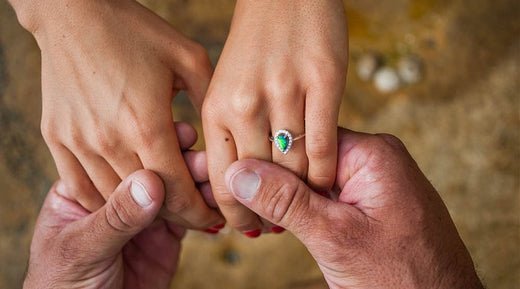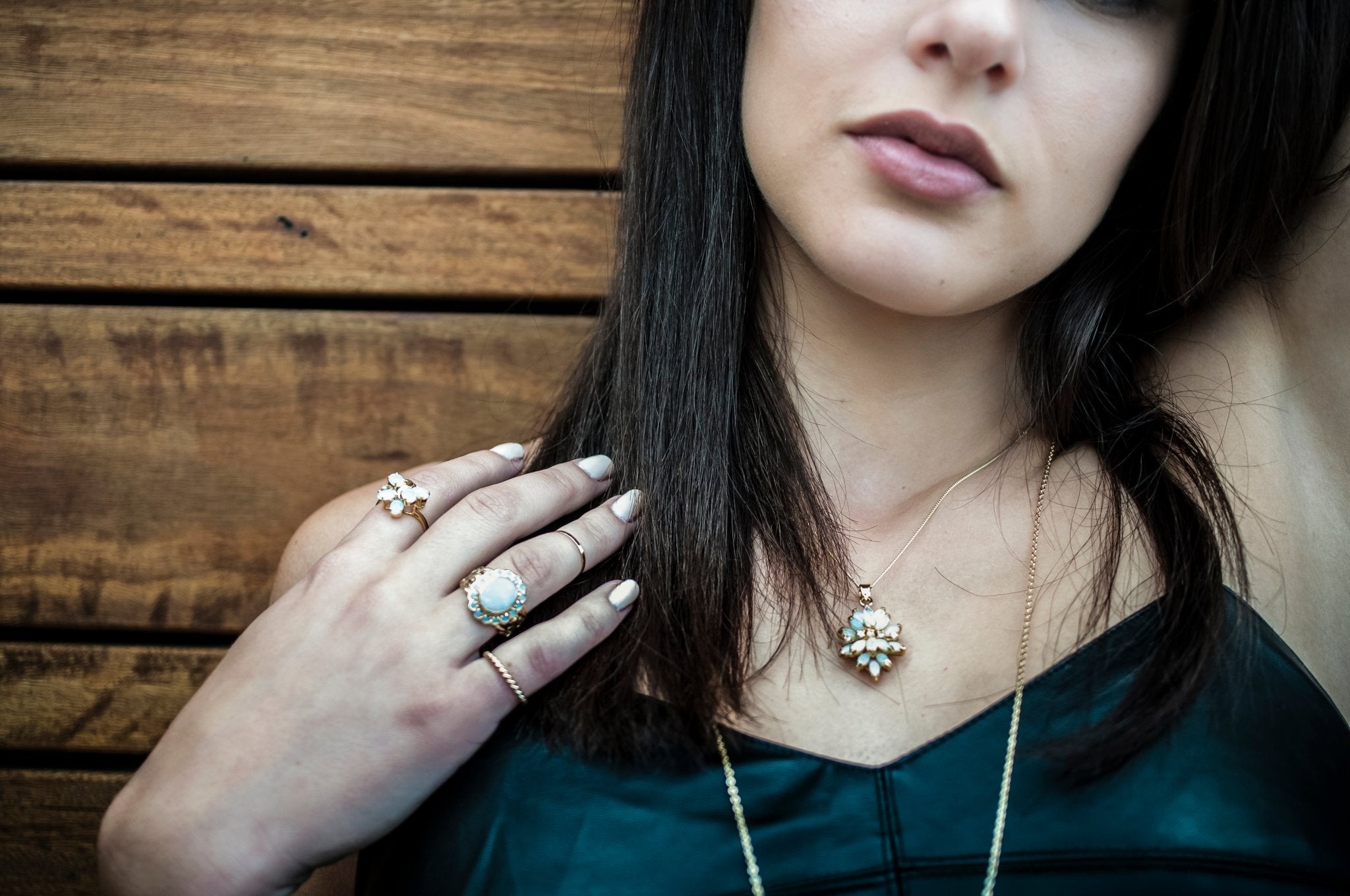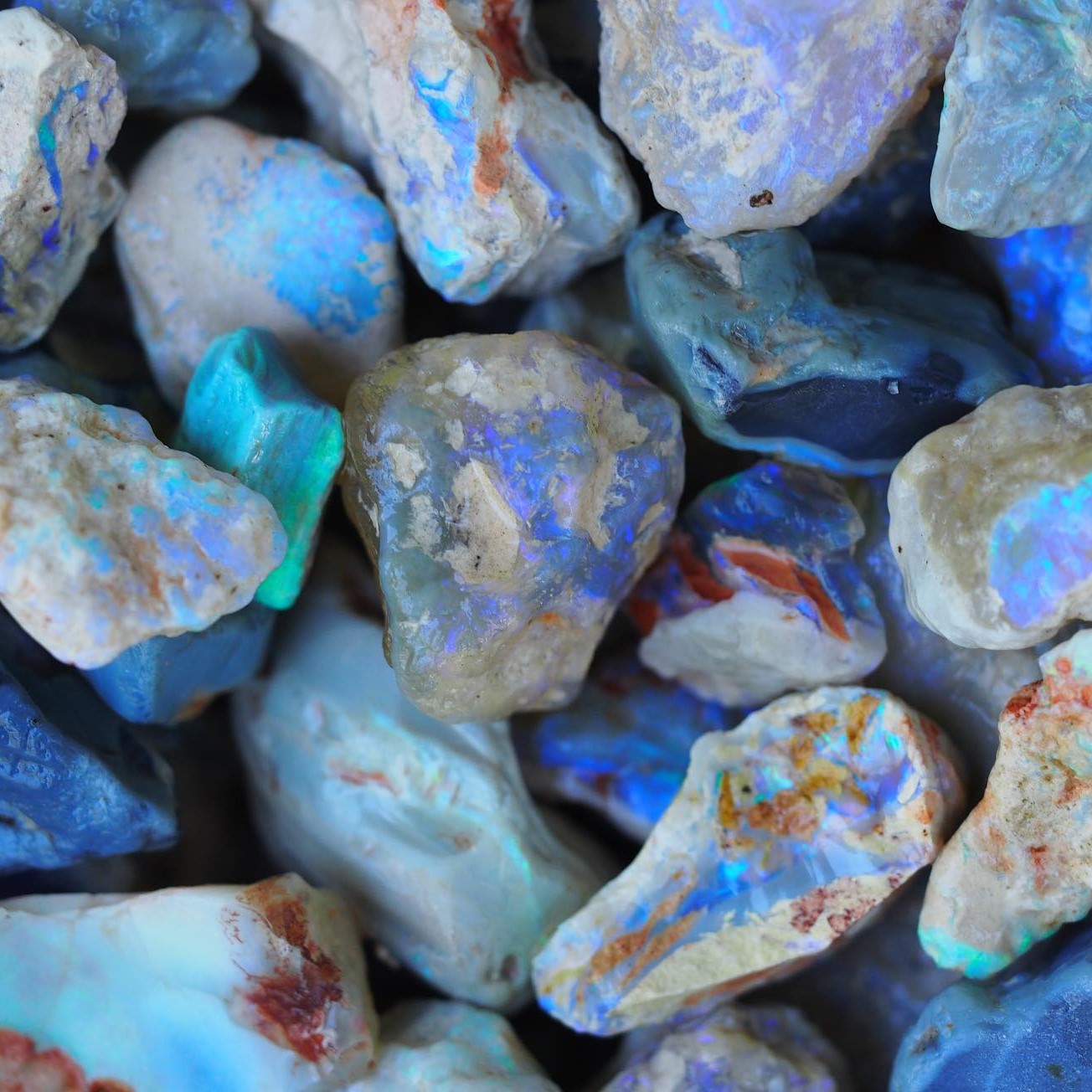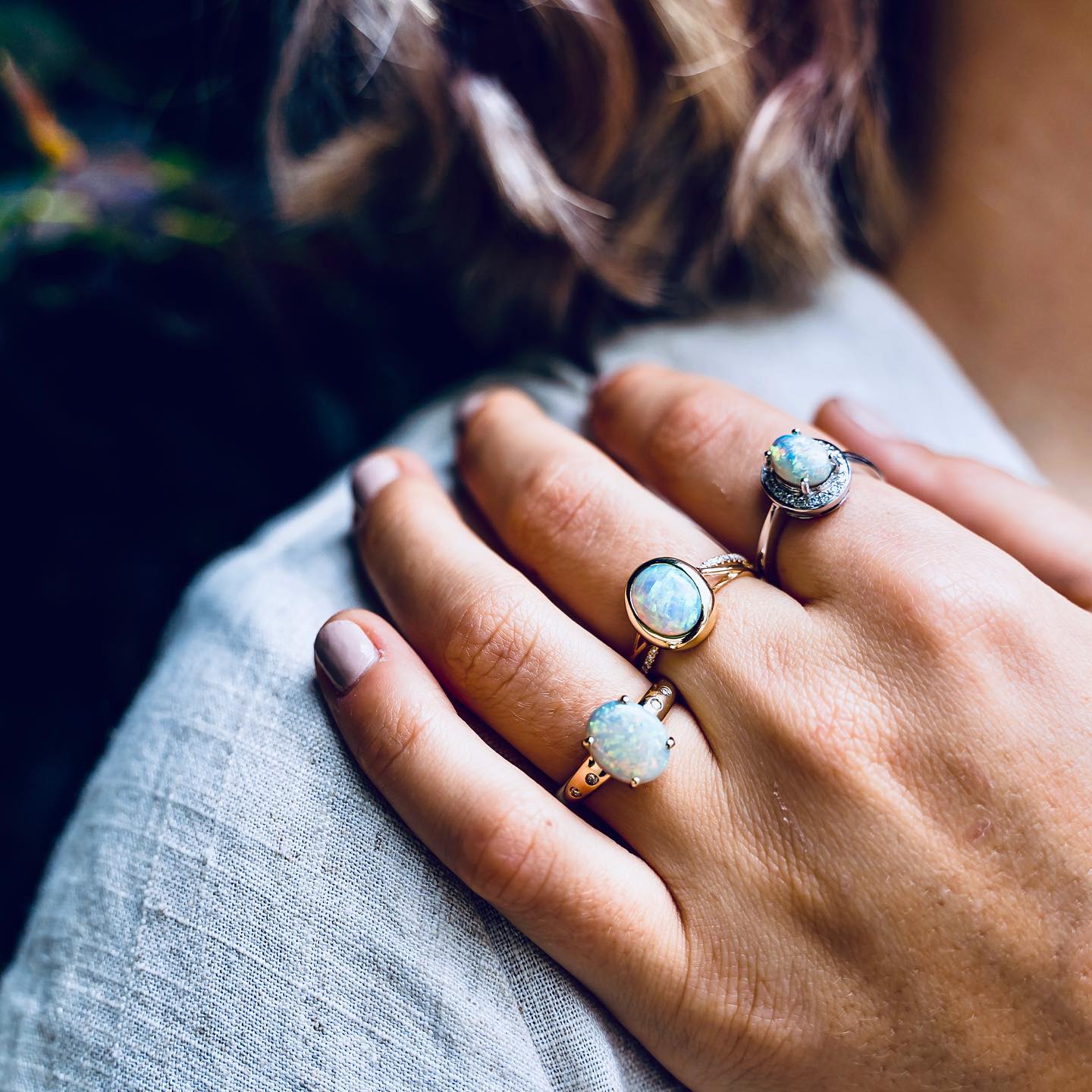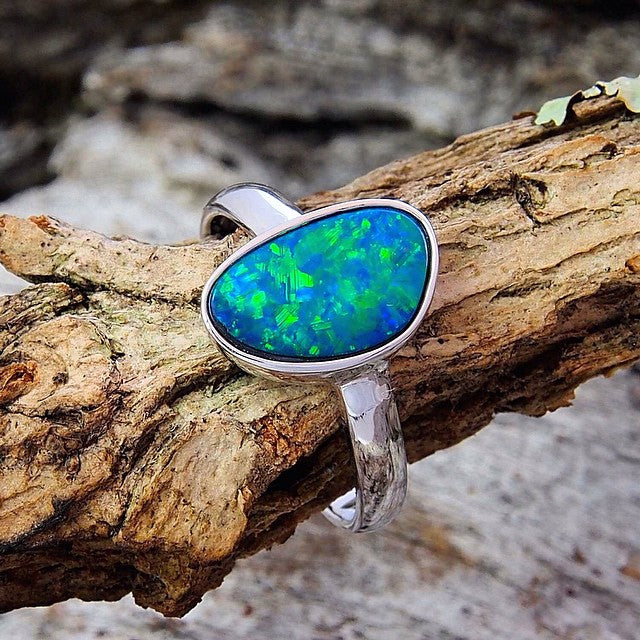
October Birthstone: An Opal Lovers' Guide
“When you look into an opal, you look into the soul of the universe.” - Unknown
Opal is a magnificent, rare gemstone known for its vibrant flashes of rainbow colours, beautiful patterns and unique radiance. As the official birthstone for October and the zodiac sign Libra, opal holds special meaning for those lucky enough to be born under this month or star sign.
So what is opal and why is this captivating gem the October birthstone? In this ultimate guide to opal, discover the history, meaning and magic behind this one-of-a-kind gemstone—and celebrate those born in October with a gift from nature that's as unique as they are.
What is the birthstone for October?
Birthstones are special gemstones assigned to each month, believed to bring luck, protection and personal significance to those born during that time. For centuries, opals have been gifted to October-born people as a way to celebrate their unique personalities and spiritual connection to this radiant stone.
Opals reflect the beauty, balance and creativity that October babies are known for. Its brilliant range of colours and unique energy are said to spark imagination and emotional harmony, making it not only a striking gemstone but a meaningful one, too.
For those born in October, wearing opal jewellery or carrying a natural opal is believed to bring good luck, positive energy and personal strength.
Opal Birthstone Benefits:
-
Symbolises hope, purity and truth
-
Encourages creativity and inspiration
-
Enhances emotional expression and self-awareness
-
Believed to bring good fortune to its wearer
-
Aligns with Libra traits: harmony, balance and aesthetic appreciation

Opal as The Libra Birthstone
Opal is also the birthstone for the zodiac air sign Libra, known for harmony, beauty and creativity. With its shifting kaleidoscopic hues, opal reflects Libra’s love of balance and artistic expression. The gemstone’s unique play-of-colour mirrors Libra’s thoughtful nature and ability to see all sides.
As a birthstone, opal is a meaningful and symbolic gift for those born under the Libra sign. It represents love, idealism and emotional connection. With its ethereal glow and spiritual energy, opal is more than just a beautiful gem—it’s the perfect stone to celebrate the Libra spirit.
What Does The Opal Birthstone Mean?
In addition to being October's birthstone, opal is one of the most spiritually significant and symbolically rich gemstones in the world. For centuries, cultures across the globe have revered opal for its beauty, mystery and deep metaphysical properties.
For Australia’s Indigenous peoples—who have the world’s oldest living culture—opal opal is a deeply spiritual stone. In Dreamtime stories, opals are seen as the creator’s footprint, marking the land with divine energy. The stone’s flashes of colour are believed to represent ancestral fire and a connection to the spirit world. Opal is viewed as a sacred gift from the Earth, offering protection and healing.
Opal has also held powerful meaning in ancient cultures. The Romans saw opal as a symbol of hope and purity, believing it contained the virtues of all gemstones. The Greeks believed opals gave the gift of prophecy and protection. In Arabic legends, opals were thought to fall from the sky in lightning, capturing their bright, magical colours.
October Birthstone Color
So what colour is the October birthstone? Known for its beautiful rainbow-like effect, opals display a unique 'play-of-colour' showing flashes of green, blue, orange, red, purple and more as the stone moves in the light. This makes each opal one of a kind, with no two showing the exact same colour pattern. The base of the opal can be light, dark or even clear, which affects how bright the colors appear.
Because of this shifting color display, there is no single October birthstone colour. Instead, opals are loved for their ever-changing mix of vibrant hues. This magical colour play is what makes opal a meaningful and eye-catching choice for anyone born in October.
The Origin of The Word 'Opal'
The name opal has deep historical roots, tracing back to ancient cultures who revered this gemstone for its unique beauty. It is believed to originate from the Sanskrit word upala, meaning 'precious stone', highlighting the value placed on it even in early times.
The Greeks referred to it as opallios, which translates to 'to see a change of colour'—a fitting tribute to the stone’s remarkable play-of-colour. The Romans also had their own version, opalus, which carried a similar meaning: 'to perceive a change in hue'. These ancient interpretations reflect a shared admiration across civilizations for opal’s magical, shifting spectrum of colour that continues to enchant wearers today.

What is Opal?
Opal is a unique and captivating gemstone formed over millions of years through a natural process involving water and silica. As water seeps through the earth, it picks up microscopic silica particles and deposits them into underground cavities.
Over time, as the water evaporates, these silica spheres are left behind, stacking in a precise, grid-like pattern. When light hits this internal structure it bends and splits, creating the vibrant play-of-colour opal is famous for—a rainbow of shifting hues that dance across the stone’s surface.
Did you know the size of the silica spheres in an opal plays a key role in the colours it displays? Larger spheres produce vibrant reds and oranges, while smaller spheres create hues like blues and greens. Because red is the rarest and most valuable colour in opal, those with larger, more uniform spheres are often the most prized.
Types of Opal
Opals come in several different types, each with their own appeal:
-
Black Opal: Dark body tone enhances vibrant colour flashes
-
White Opal: Light background with soft pastel hues
-
Boulder Opal: Natural ironstone backing enhances durability and colour
-
Crystal Opal: Transparent to semi-transparent with brilliant colour play
-
Fire Opal: Typically orange-red and often found in Mexico
-
Ethiopian Opal: Known for its vibrant play-of-colour but is more porous
Each type has unique characteristics that make it suitable for different styles and preferences.
Where is Opal Found?
While opals can be found in various parts of the world, Australia is by far the most prolific source, producing over 90% of the world’s precious opal supply. Key opal mining regions in Australia include:
-
Lightning Ridge (New South Wales): Famous for rare black opals
-
Coober Pedy (South Australia): Known for white and crystal opals
-
Andamooka (South Australia): Produces a variety of opal types
-
Queensland: Home to the unique boulder opal
Other countries that produce opals include Ethiopia, Mexico, Brazil and the United States, but Australian opals are regarded as the finest and most valuable due to their exceptional colour, stability and quality.

Benefits of Wearing Opal
Opals are not only beautiful but are also believed to offer several metaphysical and emotional benefits, which are believed to pass onto those who wear opal jewellery or carry opal stones with them:
-
Boosts creativity and originality
-
Enhances intuition and insight
-
Supports emotional healing and balance
-
Stimulates love and passion
-
Encourages spontaneity and joyful living
-
Protects against negative energy
-
Amplifies personal power and self-worth
Wearing your birthstone is a beautiful way to feel more connected to your identity and inner energy. For those born in October, adorning yourself with opal jewellery isn’t just symbolic—it’s also a stylish way to showcase the stone’s kaleidoscope of colour and individuality.
Types Of October Birthstone Jewelry
Some of the most popular and timeless ways to wear opal include opal rings, necklaces, earrings and bracelets. Each piece brings a different energy and elegance to your look. A statement opal ring is ideal for expressing creativity and confidence, while a delicate opal necklace sits close to the heart—perfect for promoting emotional clarity and self-love. Opal earrings frame the face with radiant colour, subtly enhancing your natural charm. An opal bracelet offers a touch of everyday sparkle and is believed to keep the stone’s healing energy flowing through your movements.
October Birthstone Necklace
An October birthstone necklace is a beautiful way to keep opal’s energy close to your heart. Whether set in sterling silver, white gold, or rose gold, opal pendants can be worn every day or saved for special moments. Choose a simple solitaire opal necklace for elegant minimalism, or opt for a more ornate design accented with diamonds for added sparkle. Layer with other pieces or wear alone as a standout accessory that radiates personal meaning.
October Birthstone Ring
An opal ring is a stunning and symbolic gift for October-born individuals. From dainty stackable bands to bold statement rings, opal rings can suit any personal style. The shifting colours of the opal catch the light with every hand gesture, making it a captivating piece to wear daily. Whether chosen as a birthday gift, engagement ring or personal talisman, an October birthstone ring adds a meaningful and magical touch to any jewellery collection.

October Birthstone Earrings
October birthstone earrings bring a radiant pop of colour to any look. Opal studs offer timeless sophistication, while drop or hoop styles add movement and drama. Perfect for birthdays or simply celebrating someone special, opal earrings flatter every face shape and can be dressed up or down for all occasions. Lightweight and luminous, they’re an easy way to wear your birthstone every day with grace and charm.
October Birthstone Bracelet
An opal bracelet makes a thoughtful and elegant gift that wraps the wrist in the beauty of the Queen of gems. Whether featuring a single stone or multiple opals linked in a row, these bracelets add a subtle sparkle that complements both casual and formal wear. Worn alone or stacked with other bracelets, they offer a wearable way to enjoy the positive energy and vibrant colours of your birthstone all day long.
Is the October Birthstone Valuable?
Yes, opal is a highly valuable gemstone—particularly the finest quality stones from Australia. Its value is determined by several factors, including colour, pattern, clarity, cut, and origin.
Australian black opals, especially those from Lightning Ridge, are the most prized and can fetch extremely high prices. Boulder opals and crystal opals are also highly sought-after for their striking colours and natural beauty.
Valuing an opal is a complex process that involves analysing a combination of characteristics. Here are the main factors:
-
Play-of-colour: The most important aspect. Bright, broad flashes of multiple colours are most valuable.
-
Body tone: Ranges from black (most valuable) to white or crystal. Darker body tones tend to enhance colour vibrancy.
-
Pattern: Desirable patterns include harlequin, pinfire, and rolling flash.
-
Clarity: Opals should be free from inclusions, cracks, or cloudiness.
-
Cut and shape: Well-cut opals with symmetrical shapes and smooth surfaces command higher prices.
-
Size and carat weight: Larger opals are more rare and valuable.
-
Origin: Australian opals, particularly black and boulder opals, are the gold standard.
Why Choose Australian Opal For Birthstone Gifts?
Choosing Australian opal means you're investing in a gemstone that's both naturally beautiful and responsibly sourced. It's considered the highest quality opal in the world for good reason:
-
Ethically mined by small-scale miners
-
Superior colour, durability, stability and variety
-
Rich in cultural and geological history
-
Strict quality standards ensure authenticity
As evidenced in this article, opal means far more than just a gorgeous gem—it’s a symbol of personal expression, emotional depth and spiritual connection. As the birthstone for October and a reflection of Libra’s balance and beauty, it's easy to see why opal carries a special significance for those born in this month.

